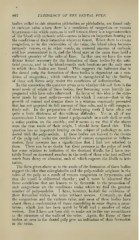Page 852 - My FlipBook
P. 852
862 PATHOLOGY OF THE DENTAL PULP.
bodies, called in this situation phlebolites or phleboliths, are found only
in varicose veins where there is a condition of congestion or venous
hypersemia—in which cases, as is well known, there is a supersaturation
of the "blood with carbonic acid—seems to have an important bearing on
the conditions of their formation wherever found. When there is venous
congestion, as in the varicosities of the veins, the blood often becomes
intensely venous, or, in other words, an unusual amount of carbonic
acid has accumulated in it, and the blood may at the same time hold a
sufficient quantity of the salts of lime. In this case we have the con-
ditions found necessary for the formation of these bodies by the arti-
ficial process, and in the blood-vessels such locations are the only ones
in which these bodies are found. This suggests the inference that in
the dental pulp the formation of these bodies is dependent on a con-
dition of congestion ; which inference is strengthened by the finding
of these soft forms only under the conditions of inflammation.
In this connection the question arises as to whether this soft form is the
usual mode of origin of these bodies, they becoming more heavily im-
pregnated with lime salts afterward. In favor of this idea is the state-
ment made by most authors—and with which I concur—that in the
growth of enamel and dentine there is a stratum constantly presented
that has not acquired its full amount of lime salts, and is still compara-
tively soft. In the preparation of developing teeth I have often cut
quite a little thickness of this without difficulty. Yet in all of my
examinations I have never found a pulp-nodule in a soft shell or with
a fsofter portion on the outside ; and it seems to me that if the above
were the true mode of their origin, I should have found this. This
question has an important bearing on the subject of pathology as con-
nected with the pulp-nodule. If these bodies are formed in the tissues
of the pulp only under the conditions of venous congestion or inflam-
mation, their presence has a signification that I bad not attached to
them. There can be no doubt but their presence in the pulps of teeth
has some relation to irritation of the dentinal fibrils, for I have cer-
tainly found an increased number in the teeth of those who had suffered
much from decay or abrasion, each of which exposes the fibrils to irri-
tation.
The facts given above as to the mode of the formation of these bodies
suggest the idea that calcoglobulin and the pulp-nodule originate in the
veins of the pulp as a result of venous congestion or hyperseraia, and
that the vessel is obliterated thereby ; and it must be admitted that
those conditions that are known to be favorable to the promotion of
such congestions are the conditions under which we find the greatest
number of pulp-nodules. I have, however, looked for evidences of
their formation within the veins without success. Certainly, we find
the congestions and the varicose veins, and most of these bodies have
about them a condensation of tissue resembling in some degree a mem-
brane ; which fact has been noted by Wedl and a number of other
writers. But I have not been able to make out in this any resemblance
to the structure of the walls of the veins. Again, the forms of these
bodies as seen in the dental pulp give no indication of their formation
in the veins.


